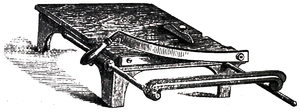sharp the paper will yield to the slight pressure required and will not be cut. It is therefore absolutely necessary that a good edge be given to the blade, and, if possible, to keep a special knife for the purpose. Such knives, called trimming knives, are sold, the probable cost being about two shillings. They have a very broad blade.
The object of trimming is to make the edges true; the amount taken off must be only the rough and dirty edges, the book being thus left as large as possible.

Cardboard Machine used for trimming.
The French put their books in the press between boards and rasp the edges, but this method has not only the disadvantage of showing all the marks of the rasp, but also of leaving a roughness which catches and retains the dust in proportion to the soft or hard qualities of the paper. Another method is to put the book into the cutting press, and cut the overplus off with a plough, having a circular knife, called a "round plough." This is used when a number of books are being done together. I prefer to use the straight edge and knife for the foredge and tail, and to cut the top when the book is in boards.
It is, however, not necessary to go to the expense of a round plough, it is only advisable to have one when "plough trimming" is of daily occurrence; an ordinary plough knife, ground to a circular edge, will answer in most cases.
Another excellent plan is to set the gauge of the mill-
